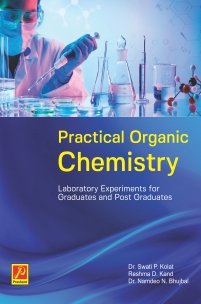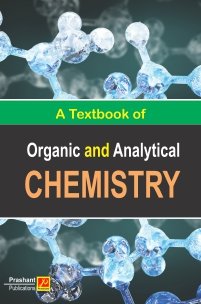Practical Organic Chemistry
Laboratory Experiments for Graduates and Post Graduates
Authors:
ISBN:
SKU:
9789390483266
Book Language: English
Published Years: 2020
Pages: 286
Edition: First
Ebook Link: https://www.kopykitab.com/Practical-Organic-Chemistry-by-Dr-Swati-P-Kolat-Mrs-Reshma-D-Kand-Dr-Namdeo-N-Bhujbal
Categories:
Chemistry, SYBSc Semester III
₹350.00
- DESCRIPTION
- INDEX
This book aims to compile various techniques, purification methods, separation of ternary mixtures, single and multiple stage synthesis, isolation of natural products, etc. under one platform.
Contents in the book are presented in the easily understandable manner aided with pictures, schemes and calculations in tabular format. The covered topics are explained in very simple language so that the students will develop interest in the field of practical organic chemistry.
The authors envisioned that this book will fulfill the requirement and serve as textbook as well as reference book for wide audience including graduate, post graduate students and teachers.
- Techniques used in laboratory : 1.1 Filtration, 1.2 Recrystallization, 1.3 Sublimation, 1.4 Distillation : 1.4.1 Simple distillation, 1.4.2 Fractional distillation, 1.4.3 Distillation under reduced pressure (vacuum distillation), 1.4.4 Steam distillation, 1.5 Extraction with solvent, 1.6 Chromatography, 1.6.1 Thin layer Chromatography, 1.6.2 Column Chromatography, 1.6.3 Paper Chromatography, 1.7 Drying of solvents
- Ternary Mixture Separation : 2.1 Nature of the mixture, 2.2 Separation of the mixture into three component, 2.3 Type of the mixture, 2.4 Purification of separated component, 2.5 Determination of physical constant, 2.6 Qualitative analysis of each component involves, 2.6.1 Preliminary Tests, 2.6.2 Element detection, 2.6.3 Functional group detection, 2.6.4 Conformation of functional group, 2.6.5 Result, 2.6.6 Derivatives preparation
- Single Stage Synthesis : 3.1 Ethyl Benzene from Acetophenone, 3.2 9,10-Dihydroanthacence-endo-α,β-succinic anhydride from Anthracene and Maleic anhydride, 3.3 p-Nitro benzyl cyanide from Benzyl cyanide, 3.4 2, 2’-Dihydroxybinaphthyl (1,1’-bi-2-naphthol) from 2-Naphthol, 3.5 Hippuric acid (benzoylglycine) from glycine, 3.6 Resacetophenone (2’,4′-Dihydroxyacetophenone, 4-Acetylresorcinol) from Resorcinol, 3.7 Terephthalic acid from p-Xylene, 3.8 Benzyl alcohol and benzoic acid from benzaldehyde, 3.9 4-Chlorotoluene from p-toluidine, 3.10 Benzilic acid from benzil (2-Hydroxy-2,2-diphenylacetic acid), 3.11 Benzopinacol from Benzophenone, 3.12 4-Methyl benzophenone from toluene, 3.13 Vanillyl alcohol (4-hydroxy-3-methoxybenzyl alcohol) from vanillin 4-hydroxy-3-methoxybenzaldehyde), 3.14 Stilbene from benzyl chloride and benzaldehyde, 3.15 Ethyl cinnamate from benzaldehyde, 3.16 Triphenylcarbinol from ethyl benzoate, 3.17 β-D-Glucose pentaacetate from D-glucose, 3.18 Cyclohexanol from cyclohexanone, 3.19 2-Phenyl indole from phenyl hydrazine and acetophenone, 3.20 5-Acetyl-6-methyl-4-phenyl-3,4-dihydropyrimidin-2(1H)-one (Pyrimidine) from Acetyl acetone, 3.21 2,4-Dimethyl-1H-benzo[b][1,4]diazepine from Acetyl acetone, 3.22 3,5-Dimethylpyrazole from Acetyl acetone, 3.23 3-Benzylidenepentane-2,4- dione, from Acetyl acetone with 1mmol benzaldehyde, 3.24 (1E,6E)-4-Benzylidene-1,7-bisphenylhepta-1,6-diene-3,5-dione (tribenzylidene acetylacetone) from Acetyl acetone and benzaldehyde, 3.25 1-Phenylazo-2-naphthol (Sudan I dye) from β-Naphthol, 3.26 6-Bromo-2-naphthol from β-Naphthol, 3.27 2-Naphthyl methyl ether from β-Naphthol, 3.28 m-Nitro acetophenone from Acetophenone by nitration, 3.29 Benzylideneacetophenone (Chalcone) from Acetophenone using benzaldehyde, 3.30 N-(1-phenylethylidene)aniline (Schiff base) from Acetophenone using aniline, 3.31 Benzoic acid and Iodoform from Acetophenone, 3.32 Salicylaldehyde phenylhydrazone from Salicylaldehyde, 3.33 2-Imino-2H-chromene-3-carbonitrile (3-cyano-2-imino-2H-1-benzopyran, 2-iminochromene) from Salicylaldehyde and Malononitrile, 3.34 2-Hydroxy-3,5-dinitrobenzaldehyde from Salicylaldehyde, 3.35 o-Formylphenoxy aceticacid from Salicylaldehyde, 3.36 Catechol from Salicylaldehyde, 3.37 D-Glucose pentabenzoylate from D-glucose, 3.38 2,3,4,6-Tetra-O-benzoyl-α,β-D-glucopyranoside from 1,2,3,4,6-Penta-O-benzoyl-α,β-D-glucopyranoside (Debenzoylation of penta-O-benzoyl glucose), 3.39 2,3,4,6-Tetra-O-acetyl-α,β-D-glucopyranoside (tera-O-acetyl glucose) from 1,2,3,4,6-Penta-O-acetyl-α,β-D-glucopyranoside (Deacetylation of penta-O-acetyl glucose), 3.40 1,2:5,6-Di-O-isopropylidene-α-D-glucofuranose from D-glucose, 3.41 3-O- Benzyl-1,2:5,6-di-O-isopropylidene-α-D-glucofuranose from 1,2:5,6-Di-O-isopropylidene-α-D-glucofuranose
- Solvent free Single Stage Synthesis : 4.1 Benzopinacol from Benzophenone, 4.2 Fthyl-3-hydroxy-3-phenylpropanoate from benzaldehyde and ethyl 2-bromoacetate, 4.3 Benzylidenemalononitrile (2-phenylmethylene malononitrile) From benzaldehyde and malononitrile, 4.4 Ethyl 2-oxocyclopentane carboxylate from Diethyl hexanedioate (Diethyl adipate), 4.5 Carrole from condensation of pentafluorobenzaldehyde and pyrrole, 4.6 7-Hydroxy-4-methyl-coumarin from resorcinol and ethyl acetoacetate, 4.7 Dihydropyrimidone from condensation of benzaldehyde, ethyl acetoacetate and urea, 4.8 4-Methyl benzophenone from toluene, 4.9 Ethyl acetoacetate from ethyl acetate, 4.10 Phenylhydrazone derivative of acetophenone, 4.11 Terephthalic acid dihydrazide (benzene-1,4-dicarbohydrazide) from dimethyl terephthalate and hydrazine, 4.12 N-benzylideneaniline from benzaldehyde and aniline, 4.13 4-Chlorobenzaldiazine from 4-Chlorobenzaldehyde, 4.14 2,4,6-triarylpyridine (Krohnke pyridine) from chalcone, 4.15 N-Phenylbenzylamine from benzaldehyde and aniline, 4.16 1-(4-Nitrophenyl)-3,3-diphenyltriazene (triazenes) from diazonium salt and diphenylamine, 4.17 Acetphenone thioacetal from Acetophenone and ethane-1,2-dithiol, 4.18 2-amino-5-phenyl thiazole from bromoacetophenone and thiourea, 4.19 2,6-dibromo-4-nitrophenol from 4-Nitrophenole, 4.20 Caprolactum from cyclohexanoneoxime, 4.21 D-mannitol phenylboronate triester from D-mannitol and phenylboronic acid, 4.22 Phenyl benzoate from benzophenone, 4.23 Catechol from 2-hydroxybenzaldehyde (salicylaldehyde), 4.24 Benzil from benzoin, 4.25 Methyl phenyl sulfoxide (methylsulfinylbenzene) by oxidation of methyl phenyl sulfide, 4.26 (L, L) Di-cysteine from L-cysteine using iodine catalyst, 4.27 Diphenyldisulfide from thiophenol in presence of MnO2
- Multistage Synthesis : 5.1 N-(1-(2-methyl-5-nitrophenyl) ethyl) aniline from 4-amino anisole, 3-acyl nitro toluene and Sodium borohydride : 5.1.1 4-Nitro anisole from Anisole, 5.1.2 4-Amino anisole from 4-nitro anisole, 5.1.3 4-Nitro toluene from toluene, 5.1.4 3-Acyl nitro toluene from 4-nitro toluene,
5.2 Amidoalkyl-2-naphthols from β-Naphthol,4- amino toluene and of 2-hydroxy benzaldehyde : 5.2.1 4-Amino toluene from 4-Nitro toluene, 5.2.2 2-Hydroxy benzaldehyde from Phenol, 5.3 5-Chloro-2-hydroxy-N-(2-methoxy-4-nitrophenyl) benzamide from 5-Chloro-2-hydroxybenzoic acid, 2-methoxy-4-nitroaniline : 5.3.1 5-Chloro-2-hydroxybenzoic acid from Salicylic acid, 5.3.2 2-Methoxy-4-nitroaniline from o-anisidine, 5.4 Quinoline synthesis by using acetophenone, 4-amino chloro benzene and styrene : 5.4.1 Actophenone from Benzene, 5.4.2 4-Amino chlorobenzene from 4-Nitrochlorobenzene - Isolation of natural product : 6.1 Isolation of pigments : 6.1.1 Hibiscus (Hibiscus rosa-sinensis), 6.1.2 Rose (Rosa indica), 6.1.3 Orange Marigold (Tagetes erecta) : 6.1.4 Sunflower (Helianthus annuus), 6.2 Isolation of essential oils : 6.2.1 Ginger (Helianthus annuus), 6.2.2 Lemongrass (Cymbopogon citratus), 6.2.3 Garlic (Allium sativum), 6.2.4 Ajwain (Trachyspermum ammi), 6.2.5 Vekhand (achorus calamus), 6.3 Isolation of medicinally important component : 6.3.1 Nimbolide or Neem leave(Azadirachta indica), 6.3.2 Eujenol from Tulsi leaves (Ocimum sanctum), 6.3.3 Chavicol from Betel leaf (Piper betle), 6.3.4 Embelin from False black pepper (Embelia ribes, Vidanga or vavding), 6.3.5 Nicotine from tobacco (Nicotiana tabacum)
RELATED PRODUCTS








